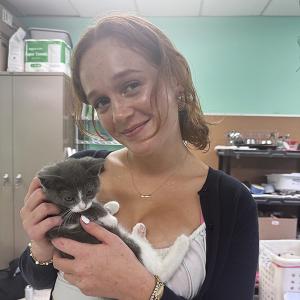Oberlin Blogs
Library Basics
September 19, 2018
Megan McLaughlin ’22
What is now over two weeks ago (yikes! self-imposed deadlines are hard!), I was lucky enough to find myself on campus, observing all of the new first-years acquainting themselves with Oberlin and working in one of my very favorite places on campus: the conservatory library.
That week, with mainly first-years on campus, I fielded lots of questions at the circulation desk about basic library information and procedures. Because I started working in the library during my first-year orientation week, I never really had the buffer zone of a few weeks or months not knowing how the college libraries work, which is not the case for most students.
I thought making a list of general library information would be helpful for students, as it isn’t often explained in black and white. Here are my 17 points, in a somewhat stream-of-consciousness order:
1. Oberlin has four main libraries: the main library (commonly referred to as Mudd, but it is soon going to be named the Mary Church Terrell Library, which will reside in Mudd Center), the conservatory library, the art library, and the science library. Each offers resources that are available to students regardless of their major or whether they are in the conservatory or the college.
2. The library has an online catalog called OBIS. You can sort item searches by author, title, keyword, etc., and also by format: recording, book or score, etc. You can also use the “My Library Record” tab in the top right corner to check on the due dates of your checked-out items, renew items, and view any fines you may have.
3. If the library does not have an item you’re looking for, you can request it from OhioLink (a system that allows students to borrow materials from other Ohio universities, and typically has a 3-5 day waiting period for the materials to arrive in Oberlin), Interlibrary Loan (an international network that has the same function as OhioLink, but may take longer depending on where the materials are being borrowed from), or you can request to have the item ordered (which means you would not get the item immediately, as it needs to be purchased and prepared for shelving, but you would be doing a favor to other/future students).
4. If the library has the item you’re looking for, but it’s checked out, you can recall it through OBIS, and the person who has it checked out will have to return it within five days of the recall. Another option is requesting it from a different library using OhioLink, which means you would get the item in roughly the same amount of time, without taking it away from someone else.
5. In addition to OBIS, there is also the Oberlin College Libraries web page, which has links to all sorts of online resources! I used ARTStor for my first-year seminar last year to look at artworks from all over the world in meticulous detail, which was very helpful for my final project. Do some exploring when you get a chance because Oberlin is subscribed to lots of databases, electronic journals, periodicals, and such that are all available to students.
6. You can view the library hours.
7. Materials in the library are shelved according to the Dewey Decimal and Library of Congress (LC) cataloging systems. All new materials the Oberlin College Libraries obtain are cataloged in LC, but Dewey Decimal precedes the Library of Congress system, and recataloging all of the Dewey items to be LC would take a lot of time and effort, so there are two separate systems.
8. The call number (series of numbers and letters on the spine or cover of an item) indicates which classification system an item is cataloged in. The call number for Library of Congress items will always start with a letter, and Dewey Decimal will start with a number.
9. There are great maps of the libraries online that make it much easier to find items if you know the call number. Here are links to main library 1st floor, main library 2nd floor, main library 3rd floor, and main library 4th floor. Art library! Conservatory 1st floor east wing, Conservatory 1st floor west wing, Conservatory 2nd floor. Science library!
10. This beautiful chart contains information about different items’ checkout period lengths, which vary based on the type of item and which library they come from.
11. This slightly less pleasant chart explains the system of fines for overdue materials.
12. Reserve items are materials professors have requested to be held for use by students taking their classes. Reserve materials are held behind the circulation desk, and generally have a checkout period of three hours. Professors sometimes list call numbers for their reserve materials on their syllabi, but if not, they can also be found using OBIS or the binders at the circulation desk (depending on what library you are borrowing reserve items from).
13. Printing! Students get $40 worth of print money at the beginning of every semester. Before you print on a library computer, you’ll be asked for your ObieID and password, which pays for whatever you’re printing. Be careful of whether or not you check the “print double-sided” box, because I have made too many accidents from that darned box.
14. If you want to print from your laptop, you can use Papercut, which also allows you to view how much print money you have remaining, and how much your recent print jobs have cost.
15. Color printing is available in the main library and the art library.
16. Copying is not included in the $40 worth of print money per semester. For copying, you can use ObieDollars, or a slightly more complicated but less expensive method, in which you scan what you want to print, have it sent by email to you, and print it out from a computer, which is included in your semesterly print money.
17. You can check out electronics, including laptops and laptop chargers, from all four of the campus libraries. iPads are also available to check out from the Main Library. The checkout periods and out of library policies vary between libraries.
That is my list! It is not a complete list of all library goings-on by any means, but I hope it can help people get on the right foot. Special thanks to my boss Greg Solow for making sure I didn’t include any false information, and lastly, always ask questions!
Although they may seem intimidating at times, the libraries are wonderful resources that all students are always welcome to use.
Similar Blog Entries
Lock-In Spots Fit for an Obie
December 22, 2024
In light of finals coming to a close, I did some reflecting upon what got me to the finish line.

And We're Rolling
December 27, 2023
Everyone should take a production class at Oberlin if they get the chance.

